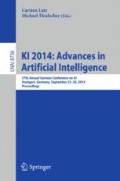Abstract
In this paper, we propose a method to combine unsupervised and semi-supervised learning (SSL) into a system that is able to adaptively learn objects in a given environment with very little user interaction. The main idea of our approach is that clustering methods can help to reduce the number of required label queries from user interaction, and at the same time provide the potential to select useful data to learn from. In contrast to standard methods, we train our classifier only on data from the actual environment and only if the clustering gives enough evidence that the data is relevant. We apply our method to the problem of object detection in indoor environments, for which we use a region-of-interest detector before learning. In experiments we show that our adaptive SSL method can outperform the standard non-adaptive supervised approach on an indoor office data set.
Access this chapter
Tax calculation will be finalised at checkout
Purchases are for personal use only
Preview
Unable to display preview. Download preview PDF.
References
Zhu, X.: Semi-supervised learning literature survey. Computer Sciences, University of Wisconsin-Madison, Tech. Rep. 1530 (2005)
Zhu, X.: Semi-supervised learning with graphs. Ph.D. dissertation, Carnegie Mellon University (2005)
Lawrence, N.D., Platt, J.C., Jordan, M.I.: Extensions of the informative vector machine. In: Winkler, J.R., Niranjan, M., Lawrence, N.D. (eds.) Machine Learning Workshop. LNCS (LNAI), vol. 3635, pp. 56–87. Springer, Heidelberg (2005)
Saffari, A., Leistner, C., Bischof, H.: Regularized multi-class semi-supervised boosting. In: Conf. on Comp. Vision & Patt. Recog., CVPR (2009)
Joachims, T.: Transductive inference for text classification using support vector machines, pp. 200–209 (1999)
Triebel, R., Paul, R., Rus, D., Newman, P.: Parsing outdoor scenes from streamed 3D laser data using online clustering and incremental belief updates. In: Robotics Track of AAAI Conference on Artificial Intelligence (2012)
Guillaumin, M., Verbeek, J., Schmid, C.: Multimodal semi-supervised learning for image classification. In: Conf. on Comp. Vision & Patt. Recog., CVPR (2010)
Ebert, S., Larlus, D., Schiele, B.: Extracting structures in image collections for object recognition. In: Daniilidis, K., Maragos, P., Paragios, N. (eds.) ECCV 2010, Part I. LNCS, vol. 6311, pp. 720–733. Springer, Heidelberg (2010)
Budvytis, I., Badrinarayanan, V., Cipolla, R.: Semi-supervised video segmentation using tree structured graphical models. Trans. on Pattern Analysis and Machine Intelligence 35(11), 2751–2764 (2013)
Settles, B.: Active learning literature survey. Tech. Rep. (2010)
Kapoor, A., Grauman, K., Urtasun, R., Darrell, T.: Gaussian processes for object categorization. Intern. Journal of Computer Vision 88(2), 169–188 (2010)
Triebel, R., Grimmett, H., Paul, R., Posner, I.: Driven learning for driving: How introspection improves semantic mapping. In: The International Symposium on Robotics Research, ISRR (2013)
Lowe, D.G.: Object recognition from local scale-invariant features. In: Proc. of the Intern. Conf. on Computer Vision (ICCV), pp. 1150–1157 (1999)
Achanta, R., Shaji, A., Smith, K., Lucchi, A., Fua, P., Susstrunk, S.: Slic superpixels compared to state-of-the-art superpixel methods. Trans. on Pattern Analysis and Machine Intelligence 34(11), 2274–2282 (2012)
Rosenberg, A., Hirschberg, J.: V-measure: A conditional entropy-based external cluster evaluation measure. In: Proc. of the Joint Conf. on Empirical Methods in Natural Language Proc. and Comp. Natural Language Learning (EMNLP-CoNLL), pp. 410–420 (2007)
Luxburg, U.: A tutorial on spectral clustering. Statistics and Computing 17(4), 395–416 (2007)
Bo, L., Ren, X., Fox, D.: Hierarchical matching pursuit for image classification: Architecture and fast algorithms. In: NIPS (2011)
Author information
Authors and Affiliations
Editor information
Editors and Affiliations
Rights and permissions
Copyright information
© 2014 Springer International Publishing Switzerland
About this paper
Cite this paper
Debnath, S., Baishya, S.S., Triebel, R., Dutt, V., Cremers, D. (2014). Environment-Adaptive Learning: How Clustering Helps to Obtain Good Training Data. In: Lutz, C., Thielscher, M. (eds) KI 2014: Advances in Artificial Intelligence. KI 2014. Lecture Notes in Computer Science(), vol 8736. Springer, Cham. https://doi.org/10.1007/978-3-319-11206-0_8
Download citation
DOI: https://doi.org/10.1007/978-3-319-11206-0_8
Publisher Name: Springer, Cham
Print ISBN: 978-3-319-11205-3
Online ISBN: 978-3-319-11206-0
eBook Packages: Computer ScienceComputer Science (R0)

